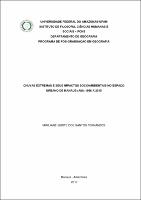| ???jsp.display-item.social.title??? |


|
Please use this identifier to cite or link to this item:
https://tede.ufam.edu.br/handle/tede/6054| ???metadata.dc.type???: | Dissertação |
| Title: | Chuvas extremas e seus impactos socioambientais no espaço urbano de Manaus (Am): 1986 a 2015 |
| ???metadata.dc.creator???: | Fernandes, Miriliane Judite dos Santos  |
| ???metadata.dc.contributor.advisor1???: | Vieira, Antonio Fábio Sabbá Guimarães |
| ???metadata.dc.description.resumo???: | Este trabalho teve como objetivo principal analisar os índices de chuvas extremas e erosividade da cidade de Manaus (AM) no período de 1986 a 2015. Assim, para atingir esses objetivos, foi feito a caracterização das variações pluviométricas (mensais e anuais) e normal climatológica da cidade de Manaus; a especificação dos padrões anômalos para período; a Identificação dos índices de erosividade da chuva a partir dos dados pluviométricos; e a descrição dos impactos socioambientais associados aos eventos extremos de chuva. Desta forma foram considerados eventos extremos de chuva somente aqueles que ultrapassaram 50 mm diários de precipitação. Nessa análise, foi utilizada uma série histórica temporal de precipitação diária e mensal do período de 1986 a 2015 da estação di INMET. Através da tabulação desses dados foi possível gerar gráficos e identificar os eventos anômalos e através da equação de Fournier (1956) foi possível identificar os índices de erosividade da chuva para o período. No que se refere à caracterização dos impactos causados pelos eventos extremos na cidade de Manaus a fonte utilizada foi através das reportagens do Jornal impresso “A Crítica”. Entre os resultados obtidos foi possível identificar que a média dos últimos 30 anos da variação pluviométrica anual foi de 2329,4mm, com destaque para o ano mais chuvoso em 2008 com total de 3157,1 e o ano de 2015 considerado menos chuvoso desse período com total 1735,7. Notou-se o aumento de eventos anômalos nas últimas décadas chegando a última década (2006 a 2015) o registro de 23 meses com episódios anômalos. Em relação às estimativas dos índices de erosividade da chuva foi possível identificar que os índices de erosividade mensais e anuais são bastante significantes para causar impacto na cidade. Notou-se que nesses últimos 30 anos ocorreram 82 eventos extremos, com 16 anos sob influência dos fenômenos La Niña e El Niño e 14 sem a influência destes. Os principais impactos causados estavam relacionados a alagações e enchentes, deslizamento de terra, desabamento de casas e alguns casos com vítimas de afogamento. |
| Abstract: | The main objective of this work was to analyze the extreme rainfall and erosivity indices of the city of Manaus (AM) in the period 1986 to 2015. Thus, to reach these objectives, the characterization of pluviometric variations (monthly and annual) and normal climatological Of the city of Manaus; Specification of anomalous patterns for period; A Identification of rainfall erosivity indices from rainfall data; And the description of socio-environmental impacts associated with extreme rainfall events. In this way, only those that exceeded 50 mm of precipitation were considered extreme rainfall events. In this analysis, a daily historical series of daily and monthly precipitation of the period from 1986 to 2015 of the INMET station was used. Through the tabulation of these data it was possible to generate graphs and identify the anomalous events and through the Fournier equation (1956) it was possible to identify the rainfall erosivity indexes for the period. Regarding the characterization of the impacts caused by the extreme events in the city of Manaus, the source used was through the newspaper reports "A Crítica". Among the results obtained, it was possible to identify that the mean of the last 30 years of the annual rainfall was 2329.4mm, with the highlight being the rainy year in 2008 with a total of 3157.1 and the year 2015 considered less rainy during that period Total 1735.7. The increase in anomalous events in the last decades reached the last decade (2006 to 2015) the record of 23 months with anomalous episodes. In relation to the estimates of the rainfall erosivity indices, it was possible to identify that the monthly and annual erosivity indices are low to cause impact in the city. It was observed that in the last 30 years 82 extreme events occurred, with 16 years being influenced by the phenomena La Niña and El Niño and 14 without the influence of the phenomena. The main impacts were related to floods and floods, landslides, house collapses and some cases of drowning. |
| Keywords: | Eventos Extremos Erosividade Impactos socioambiental |
| ???metadata.dc.subject.cnpq???: | CIÊNCIAS HUMANAS: GEOGRAFIA: GEOGRAFIA REGIONAL |
| Language: | por |
| ???metadata.dc.publisher.country???: | Brasil |
| Publisher: | Universidade Federal do Amazonas |
| ???metadata.dc.publisher.initials???: | UFAM |
| ???metadata.dc.publisher.department???: | Instituto de Filosofia, Ciências Humanas e Sociais |
| ???metadata.dc.publisher.program???: | Programa de Pós-graduação em Geografia |
| Citation: | FERNANDES, Miriliane Judite dos Santos. Chuvas extremas e seus impactos socioambientais no espaço urbano de Manaus (Am): 1986 a 2015. 2017. 113 f. Dissertação (Mestrado em Geografia) - Universidade Federal do Amazonas, Manaus, 2017. |
| ???metadata.dc.rights???: | Acesso Aberto |
| ???metadata.dc.rights.uri???: | http://creativecommons.org/licenses/by-nc-nd/4.0/ |
| URI: | http://tede.ufam.edu.br/handle/tede/6054 |
| Issue Date: | 7-Aug-2017 |
| Appears in Collections: | Mestrado em Geografia |
Files in This Item:
| File | Description | Size | Format | |
|---|---|---|---|---|
| Dissertação - Miriliane Fernandes.pdf | 20.28 MB | Adobe PDF |  Download/Open Preview |
This item is licensed under a Creative Commons License





